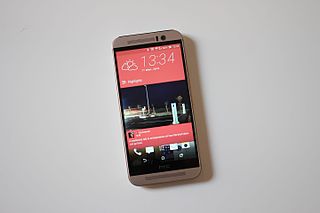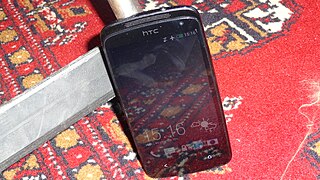
Meizu Technology Co., Ltd. is a Chinese consumer electronics company based in Zhuhai, Guangdong. Founded in 2003 by Jack Wong, Meizu began as a manufacturer of MP3 players and later MP4 players. In 2008, Meizu moved its focus to smartphones. Meizu is the 11th largest smartphone manufacturer in the world, and sold over 20 million units in 2015. In February 2015, Alibaba invested $590 million in Meizu, acquiring an undisclosed minority stake.
HTC Sense is a software suite developed by HTC, used primarily on the company's Android-based devices. Serving as a successor to HTC's TouchFLO 3D software for Windows Mobile, Sense modifies many aspects of the Android user experience, incorporating additional features, additional widgets, re-designed applications, and additional HTC-developed applications. The first device with Sense, the HTC Hero, was released in 2009. The HD2 running Windows Mobile 6.5, released later the same year, included Sense. Following the release of the Hero, all future Android devices by HTC were shipped with Sense, except for the Nexus One, the T-Mobile G2, the HTC First, the Google Pixel and Pixel 2, and the Nexus 9 which used a stock version of Android. Also some HTC smartphones that are using MediaTek processors come without HTC Sense.

HTC is the original design manufacturer for many Android and Windows Phone-based smartphones and PDAs. Brands that market or previously marketed HTC-manufactured products include Dell, Fujitsu Siemens, HP/Compaq, i-mate, Krome, O2, Palm, Sharp Corporation, and UTStarcom. HTC also manufactures ultra-mobile PCs, and is also the manufacturer of the Nexus One and Nexus 9, a smartphone and tablet designed and branded by Google, respectively.

The HTC Desire Z is a smartphone developed by the HTC Corporation that was announced on 15 September 2010 and was released in Europe and Canada in November 2010, following a number of delays related to Google's quality assurance tests. The HTC Desire Z features similar specifications to the HTC Desire and the HTC Desire HD but is a slider. The design of the HTC Desire Z has capacitive face buttons rather than the mechanical ones the HTC Desire features.

The HTC Sensation is a smartphone designed and manufactured by HTC Corporation that runs the Android 2.3 Gingerbread software stock. Officially announced by HTC on April 12, 2011, the HTC Sensation was launched by Vodafone in key European markets including the United Kingdom on May 19, 2011 and by T-Mobile in the United States on June 12, 2011. It was HTC's fifth flagship Android phone and the first HTC phone to support the HTC Sense 3.0 user interface. At the time of its release, the Sensation XE was the world's fastest Android phone.
The Droid Incredible 4G LTE, also known as the HTC Incredible 4G or Incredible 3, is a smartphone designed and manufactured by Taiwan's HTC Corporation that runs the Android 4.0 operating system (ICS). Officially announced by Verizon on May 7, 2012, for CTIA, and released on July 5, 2012, through Verizon Wireless for $149.99 with a new two-year contract. The Droid Incredible 4G LTE is the successor to the HTC Incredible S.

The HTC Butterfly is an Android-based, 4G LTE-capable smartphone designed and developed by HTC. First announced for release in Japan by Japanese carrier KDDI as the HTC J Butterfly (HTL21), the J Butterfly was released in Japan on 9 December 2012 as the successor to the HTC J. Outside Japan, in other Asian countries, the phone was released as the HTC Butterfly (X920d) and in China and Russia as the HTC Butterfly (X920e). The Chinese/Russian and US versions of the Butterfly do not have a microSD slot. In the United States, the Butterfly was released as the HTC Droid DNA as a Verizon exclusive, supporting wireless charging. The DNA would become Verizon's final non-Motorola Droid smartphone; following its replacement in August 2013 by the HTC One and Droid Maxx, the carrier announced that all future Droid phones would be built exclusively by Motorola. In June 2013, the Butterfly was succeeded by the HTC Butterfly S.
The HTC First is an Android smartphone released by HTC on April 12, 2013. It was unveiled on April 4, 2013, as part of a press event held by Facebook. Serving as a successor to a pair of Facebook-oriented devices HTC released in 2011, it was the first and only Android device to be pre-loaded with Facebook's own user interface layer, Facebook Home, in lieu of HTC's own Sense.

Facebook Home was a user interface layer for Android smartphones. Developed by Facebook, the software was designed to be a drop-in replacement for the device's existing home screen ("launcher"). It provided a replacement home screen that allowed users to easily view and post content on Facebook along with launching apps, a replacement lock screen that displayed notifications from Facebook and other apps, and an overlay which allowed users to chat via Facebook messages or SMS from any app. Facebook Home was unveiled at a press event on April 4, 2013, and was released on April 12, 2013 for a limited selection of devices from HTC and Samsung Electronics—including the HTC First, a new smartphone pre-loaded with the software. Facebook is no longer supporting or providing updates for Facebook home.

The HTC Butterfly S is an Android smartphone designed and manufactured by HTC. It is exclusive to Asian countries and currently has not been officially released in North America or Europe. The Butterfly S was unveiled on 19 June 2013 for release in Asian markets by July 2013. It is the successor to the HTC Butterfly, and incorporates hardware and software features first introduced by the HTC One, but is distinguished from the One by a larger, 5-inch 1080p display, a larger 3200 mAh battery and a Snapdragon 600 quad-core processor clocked at 1.9 GHz. The Butterfly S has a shiny plastic unibody compared to the aluminum unibody of the One, and has three capacitive buttons instead of two. It lacks the optical image stabilization of the One and the waterproofing of the original Butterfly. It has 16GB of internal storage and a microSD card slot for storage up to 64GB. The international 901s variant sold in Asian countries such as Singapore and Hong Kong has support for 4G LTE. The original Taiwanese version (901e) does not have LTE support and is currently available unlocked or on a contract with various carriers (initially only Chunghwa Telecom. An LTE version for Taiwan was announced in January 2014, following the implementation of LTE by various Taiwanese carriers. In China, two variants were released, a regular version with a 3200 mAh battery and a dual SIM version with a 2300 mAh battery. Only the Taiwanese variants officially received Android 5.0.2 Lollipop.

The HTC One Mini is an Android smartphone designed and manufactured by HTC. Alternatively known as the HTC M4, HTC 601e or HTC 601s, the One Mini is a mid-range variant of HTC's 2013 flagship high-end smartphone, the HTC One. As such, the One Mini was designed to provide an overall experience as similar to its high-end counterpart as possible, while still being competitively priced in comparison to other smartphones in its range. Officially unveiled on 18 July 2013, the One Mini was released in selected markets in August 2013 followed by a global release in September 2013.

The HTC One Max is an Android phablet smartphone designed and manufactured by HTC. The device is a larger variant of HTC's 2013 flagship high-end smartphone, the HTC One, notably incorporating a 5.9-inch display and fingerprint recognition features.
The HTC Desire 601 is an Android smartphone designed and manufactured by HTC. The Desire 601 is a mid-range device carrying design traits from the HTC One and One Mini, utilizing a dual-core processor, 4.5-inch qHD display, and offering LTE support.

The HTC One Mini 2 is an Android smartphone designed and manufactured by HTC. The One Mini 2 is a mid-range variant of HTC's 2014 flagship high-end smartphone, the HTC One. As such, the One Mini 2 was designed to provide an overall experience as similar to its high-end counterpart as possible, while still being competitively priced in comparison to other smartphones in its range. Officially unveiled on 15 May 2014, the One Mini 2 was expected to be released mid-June in Europe, the Middle East and Asia, with no official date for other regions. On Verizon Wireless, the model is branded as the HTC One Remix. The Remix differs from the One Mini 2 in that it has 1.5 GB of RAM.

The HTC One M9 is an Android smartphone manufactured and marketed by HTC. The third-generation One was officially unveiled in a press conference at Mobile World Congress on March 1, 2015 and it was released to wide retail availability on April 10, 2015. It is the successor to HTC One (M8).

The HTC Desire 500 is a low-mid-range Android smartphone released by HTC in 2013.













